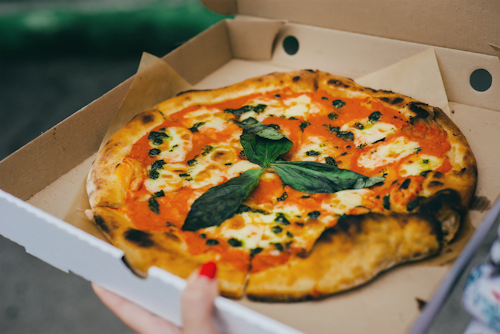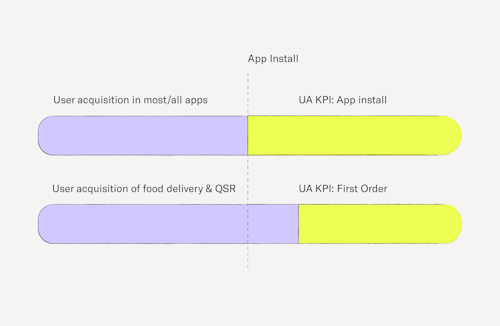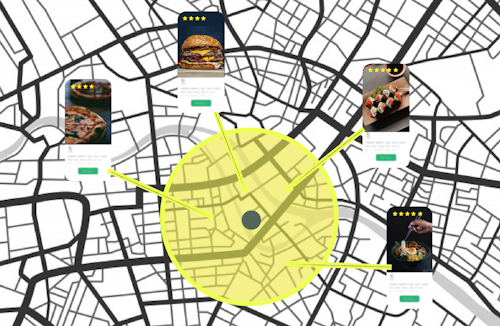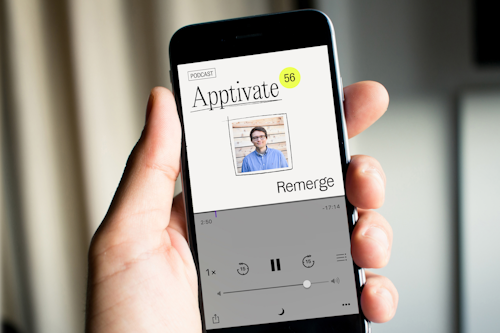On-Demand Delivery: Make Retargeting A Part of Your UA Strategy
June 09, 2020

How many of your users have your app installed, but never placed their first order? ‘Install’ is not synonymous with ‘acquisition’, and you probably don’t measure the success of your campaigns with the Cost Per Install KPI, but with the Cost Per Acquisition KPI. In this post, we’ll dive a little deeper into the concept of app retargeting as a necessary user acquisition channel.
The user acquisition game plan
App marketers are employing significant resources into user acquisition campaigns. The marketing stack involves a myriad of traction channels such as search engine ads, branded materials (in the case of food apps, supplying take-out/delivery paper bags and restaurant front-door stickers), offline ads like TV and ambient, App Store Optimization (ASO), and more — all of which aim to drive app revenue, brand loyalty, and ideally, increasing app store ranking.
With an install strategy in mind, the overarching goal of performance marketing is user loyalty. Loyalty is defined by users coming back to the app on their own, repeatedly converting and bringing in revenue. Investing lump sums in developing loyalty features or install campaigns won’t be worth anything if the majority of users don’t actually use what the app is for — in this case, ordering food for delivery or pick-up.
Retention and the problem with relying on push
So why bother with app retargeting if you already have push notifications and/or email marketing in place? When it comes to the re-engagement strategy, retargeting falls in the same line with push notifications since both aim for the same goal: get the user back on the app to convert. We want them to successfully sign in and place their first delivery order, and eventually order again (and again).
However, only 53.3% opt-in for push notifications. While relying on just push notifications may have shown improved re-engagement performance over the last few years, a significant portion of the users are still left out from re-engagement campaigns. The same applies to email marketing where open rates average at 20%.
There’s lost opportunity in not reaching all the users who installed your app. So, while you can reach a significant percentage of your audience through these efforts, can you say with certainty that you’ve done all you can to capture potential customers who have shown interest in your service? App retargeting brings advertisers a step closer to maximizing their ability to stay at the top of customers’ minds. Retention, just like acquisition, isn’t a matter of ‘either/or’, but a mix of different growth tactics.
So how exactly is retargeting a user acquisition channel?

The KPIs say it loud and clear: Cost Per Action (CPA), Customer Acquisition Cost (CAC), and cost per incremental first order.
Our clients only measure retargeting success based on these KPIs — metrics defined by app marketers themselves. While user acquisition was conventionally known to end upon app installation, this approach is no longer the case for food delivery and quick service restaurant (QSR) apps. For these apps, an acquisition is successful only when the first order is placed. The order marks the end of the acquisition process.
When the user doesn’t engage in the app — or worse, if they delete it, the investment cost of acquiring them is wasted. The majority of the uplift tests we’ve run for food delivery apps show that the higher volume of incremental conversions come from recent installers. This means that they just needed the extra push to make their first order. Planning retargeting as a small incremental investment to the acquisition budget will drive user lifetime value (LTV) and pays off in the long run.
All forces on the first order

When driving in-app orders, getting the user to order for the first time (activation) is challenging, since it requires them to go through the entire purchase and login funnel. Once activated, a significant portion of users will likely return to the app and place repeat orders (retention).
The likelihood of users coming back to order again has a lot to do with their first experience, so user experience is still paramount for success. Considering the user experience within your re-engagement strategy is key for increasing the loyal users pool. That includes both the experience within the app itself and that of the ad campaign.
A great app that lacks a proper retargeting strategy will likely have lost opportunities. At the same time, a perfect retargeting strategy can’t make up for a poor in-app experience. As app retargeting experts, we have compiled tips in perfecting the creative strategy.
To achieve the long-term success of keeping the user engaged, you’ll need to use:
- Top-rated vendors: Show the top-rated vendors within ads — taste and delivery time is an important part of the user experience! Don’t gamble with random restaurants; instead, choose the best ones and endorse those.
- Real-time feed: Have a dynamic product feed that displays only the vendors who are operating in real-time. After all, what is the point of clicking through and having the intention to order, if the restaurant is closed?
- Geolocation: Match the geolocation of users and their surrounding restaurants that are open for delivery/pick-up. Waiting time is everything these days, hence the ‘money back guarantee’ offered by some services.
- Deep linking: Bring the user directly to the menu of the very restaurant featured within the ad right after they click on it. Let them skip all the steps and take them straight to the point of interest. This can be done with the proper implementation of deep links and universal links, which are proven to boost performance.
Whether the user ends up ordering from the restaurant that was endorsed in the ad or not is entirely up to them, but one thing’s for sure: app retargeting brings them back at the right time, and as close as possible to the right place (we can’t predict food cravings, but we can certainly influence them).
Allocating retargeting spend from the user acquisition budget
So now you’re ready to retarget, but this question comes to mind: “How much of my UA budget should go to retargeting?”
It depends. Is that budget only for mobile marketing activities? Do you have to split it between install and retargeting campaigns, or is there a broader budget that also includes offline marketing efforts such as TV, radio, and more? What are all your efforts?
Unless your app is getting a significant number of organic installs daily, you’ll have to budget retargeting into your UA cost. How much exactly, depends from app to app. Some do a 50/50 install-to-retargeting campaign split, while others allocate a larger amount for retargeting since their app is already quite established, as they still have to drive the acquisition.
For newer apps, entering the market where brand awareness and market share is low or close to none, you’ll still need to run extensive install and awareness campaigns. That means retargeting would come at a later stage. Here, an 80/20 split is more sensible to start with, which can later be adjusted based on performance goals. That means retargeting needs to come at a later stage when your volume of installs reaches a threshold where retargeting can drive real business impact.
Organic cannibalization isn’t a thing to worry about anymore
“If we’re spending so much money and getting good engagement, is it possible that the retargeting partner is targeting those who would have converted organically anyways?”
For apps that have been investing in retargeting and seeing positive results, there’s always the valid concern of wrongly attributing the conversion or cannibalizing on the organic users (i.e. they would have made an order anyway without the extra push from ads).
Incrementality measurement has become the fundamental way to track and accurately see the value of different marketing efforts. Marketers are able to see the effect of retargeting and other channels using a scientifically-backed method, where the numbers not only prove but show which segments are the most influenced by ads.
Conclusion
Within performance marketing, the terms ‘install’ and ‘acquisition’ are often used interchangeably. For on-demand delivery apps, the acquisition is sealed only when the user has successfully made an order on the app.
By changing the perspective of retargeting as not only a retention tool but also an acquisition booster, marketers will see higher volumes of first order conversions in the long run. Employing tactics like highlighting top-rated vendors, using geolocation, displaying real-time feed, showing relevant messaging, and more, will maximize each conversion opportunity. Finally, by tracking your success with scientifically-based methods such as incrementality measurement, you’ll be able to grow your loyal user pool in no time.




